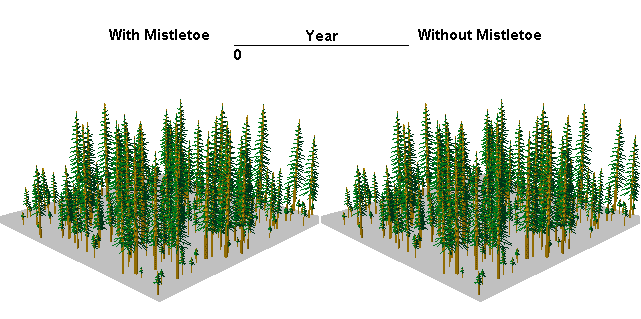FVS Models & Event Monitor Files
Dwarf Mistletoe Model
The Dwarf Mistletoe Model simulates Arceuthobium spp.
Disease Description
Dwarf Mistletoe, Arceuthobium spp
Model Description
The Interim Dwarf Mistletoe Impact Model (IDMIM), an extension to the Forest Vegetation Simulator (FVS), simulates the reduced growth and increased mortality due to dwarf mistletoes on their host tree species throughout the western United States. Spread and intensification of dwarf mistletoe are the focus of the natural resource manager when specifically addressing dwarf mistletoe in a stand; because representation of the spatial component for the spread of mistletoe within a non-spatial model can be intimidating, the spread of dwarf mistletoe is modeled in a simplified fashion with only a few parameters. The model is based on the Hawksworth six-class dwarf mistletoe rating (DMR) (Hawksworth 1977) for trees and stands. Just as dwarf mistletoe is species-specific, so is the model: it operates using species-specific parameters that can be modified by keyword if necessary.
This model is unique in its integration with FVS. The IDMIM will automatically be invoked when dwarf mistletoe damage codes are present in the FVS input tree data, but the user may turn the extension off if desired. The fact that the IDMIM was active in a simulation is not particularly obvious to the novice user because detailed IDMIM output must be requested by use of one or more keywords. Another detail of this model that makes it unique is FVS's acknowledgement of dwarf mistletoe-infected trees and the ability to preferentially target these trees for removal with cutting prescriptions.
There are a variety of statistical summaries and reports available from IDMIM that allows users to track the spread and intensification of dwarf mistletoe in a stand during the simulation period. These outputs enable users to easily evaluate the relative effectiveness of multiple management scenarios, whether the desired future condition is retention or enhancement of dwarf mistletoe for special habitat purposes or reduction and control. A complete description of the extension, its inputs, and its outputs are presented in "Interim Dwarf Mistletoe Impact Modeling System, Users Guide and Reference Manual" by Frank G Hawksworth et al., published by the USDA Forest Service, Forest Pest Management, as Report MAG-91-3 (1992; revised: 1993).
Dwarf Mistletoe Animation
This animated image represents a stand of Douglas-fir in the Fremont National Forest as simulated with the South Central Oregon Northeastern California variant of the Forest Vegetation Simulator (FVS) and the Dwarf Mistletoe Model. The images on the left are the results of a simulation with the Dwarf Mistletoe Model active and those on the right are the results with the Dwarf Mistletoe Model turned off, which is what you could reasonably expect without dwarf mistletoe present in the stand. The original stand has significant dwarf mistletoe infection, roughly 70% of the trees are moderately infected at the time of inventory. An additional characteristic of the stand is the presence of larger/overstory infected trees that hurries dwarf mistletoe spread and intensification on smaller/understory host trees.

Documentation
Methods Application Group
Unpublished Report
October 2005
Dwarf Mistletoe Model User's Guide (613 KB PDF)
Keyword Guide
Dwarf Mistletoe Model Keyword Guide (69 KB PDF)
Download

Dwarf mistletoe (Arceuthobium sp.) on a ponderosa pine. Photo by William Jacobi, Colorado State University.

